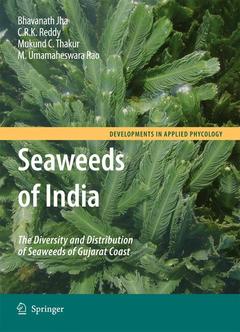Seaweeds of India, 2009 The Diversity and Distribution of Seaweeds of Gujarat Coast Developments in Applied Phycology Series, Vol. 3
Langue : Anglais
Auteurs : Jha Bhavanath, Reddy C.R.K., Thakur Mukund C., Rao M. Umamaheswara

India has 7,500 km of coastline with diverse habitats and rich biota. Coastal ecosystems, unfortunately, are experiencing wide range of pressures due to siltation, eutrophication, coastal development, aquaculture and climate change. Those species that adapt to these pressures will expand their living boundaries while others may fade away. Accordingly, the study of coastal biodiversity is of great concern globally and constitutes an important element of global change research. Gujarat has 1,600 km of coastline, reportedly with rich diversity of seaweeds. Previously published accounts on seaweed biodiversity were mainly in the form of checklists, the earliest among these being the checklist of Krishnamurthy and Joshi prepared in the early 1970s. The more recent checklists are based almost entirely on secondary information. The present book entitled Seaweeds of India ? The Diversity and Distribution of Seaweeds of Gujarat Coast is a timely publication based wholly on primary data. Data were collected through extensive and systematic ? eld studies conducted by the authors during different seasons over a three year period. The authors collected nearly 200 species of seaweeds belonging to 100 genera of Chlorophyta, Phaeophyta and Rhodophyta. Twenty-four of the species are new to Gujarat coast and three are new to Indian waters. The book contains high-quality images of the different species in their existing habitats. Brief taxonomical descriptions, together with information on ecology, distribution, seasonality and abundance, are covered for each of the species.
Chlorophyta.- Ulotrichales, Monostromataceae.- Ulvales, Ulvaceae.- Acrosiphoniales, Acrosiphoniaceae.- Cladophorales, Cladophoraceae.- Siphonocladales, Boodleaceae.- Bryopsidales, Bryopsidaceae.- Dasycladales, Dasycladaceae.- Phaeophyta.- Ectocarpales, Chordariaceae.- Dictyotales, Dictyotaceae.- Scytosiphonales, Scytosiphonaceae.- Fucales, Sargassaceae.- Rhodophyta.- Bangiales, Bangiaceae.- Nemaliales, Scinaiaceae.- Ahnfeltiales, Ahnfeltiaceae.- Gelidiales, Gelidiaceae.- Gracilariales, Gracilariaceae.- Bonnemaisoniales, Bonnemaisoniaceae.- Cryptonemiales, Corynomorphaceae.- Halymeniales, Halymeniaceae.- Corallinales, Corallinaceae.- Gigartinales, Caulacanthaceae.- Nemastomatales, Nemastomataceae.- Sebdeniales, Sebdeniaceae.- Rhodymeniales, Champiaceae.- Ceramiales, Wrangeliaceae.
The first book of its kind describing the current status of marine macroalgal flora in India Data complements the gaps in global algal databases Full colour photos of each species in natural conditions enabling rapid identification
Date de parution : 07-2014
Ouvrage de 215 p.
19.3x26 cm
Disponible chez l'éditeur (délai d'approvisionnement : 15 jours).
Prix indicatif 158,24 €
Ajouter au panierDate de parution : 06-2009
Ouvrage de 215 p.
20.3x27.6 cm
Thèmes de Seaweeds of India :
© 2024 LAVOISIER S.A.S.



